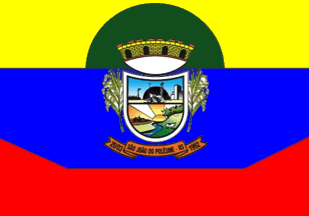 image by Diogo Marchesan, 5 August
2020
image by Diogo Marchesan, 5 August
2020
Last modified: 2020-08-08 by ian macdonald
Keywords: rio grande do sul | são joão do polêsine |
Links: FOTW homepage |
search |
disclaimer and copyright |
write us |
mirrors
 image by Diogo Marchesan, 5 August
2020
image by Diogo Marchesan, 5 August
2020
The municipality of São João do Polêsine (2,552 inhabitants in 2019; 7,832
ha) is located 230 km north-west of Porto Alegre. The municipality is cmmposed
of the districts of São João do Polêsine (seat), Vale Vêneto and Recanto
Maestro.
The municipality is named for the region of origin of most its
earlier colonists, Polesine (Venetia, Italy).
Ivan Sache, 5 August 2020
The flag of São João do Polêsine is prescribed by Municipal Law No. 81
promulgated on 11 May 1994.
Article 1.
The flag of the municipality of
São João do Polêsine is represented in the Appendix, which is part of the Law,
with the following symbolism.
Yellow color - represents income, the fruit of
advanced technologies of rice cropping, which is the municipality's basic source
of income.
Green color - represents the mountains, the rainforest, the fields
and hope.
Blue color - represents river Soturno that irrigates the
municipality's arable lands.
Red color - represents fire, industry and
people's aspiration to progress.
Coat of arms - as prescribed by Municipal
Law no. 22 promulgated in 1993.
https://leismunicipais.com.br/a/rs/s/sao-joao-do-polesine/lei-ordinaria/1994/9/81/lei-ordinaria-n-81-1994-institui-a-bandeira-do-municipio-de-sao-joao-do-polesine
Leis Municipais database
The coat of arms of São João do Polêsine is
prescribed by Municipal Law No. 22 promulgated on 22 April 1993.
Article
1.
The flag of the municipality of São João do Polêsine is represented in the
Appendix, which is part of the Law, with the following symbolism.
The crown
represents the coronation of an aspiration, of a goal and of an objective,
emancipation and independence.
The rice represents a resource for a
municipality, pioneerism and advanced technology that makes of this culture the
municipality's main source of income.
The locomotive represents pioneerism of
technology in rice cultivation since the municipality's colonization in 1893.
The church represents religious feeling, a tradition brought and maintained by
the colonizing immigrants, the sign of the people's faith.
The man with the
tractor represents work, construction of the municipality and of a progressist
land through the implementation of the most updated technology for cultivation
of its main crop, rice.
The forest represents the struggle of the colonists
who developed the land through their work.
The river represents the origin of
the name Polêsina, homonym of the Italian region on the banks of river Po, by
comparison with river Saturno's fertility and beauty.
The town's skyline
represents progress. The rays represent the sun and life.
Cattle represents
cattle-breeding in the municipality.
Green represents fields and hope.
Blue represents the sky and the rivers' water.
Yellow represents wealth.
Red represents industry.
https://leismunicipais.com.br/a/rs/s/sao-joao-do-polesine/lei-ordinaria/1993/3/22/lei-ordinaria-n-22-1993-institui-o-brasao-no-municipio-de-sao-joao-do-polesine
Leis Municipais database
Photo
https://societapolesine.blogspot.com/2012/01/convite-societa-amici-ditalia-polesani.html?m=0
Image above by Diogo Marchesan, Wikimedia Commons
https://pt.wikipedia.org/wiki/Ficheiro:Bandeira_São_João_do_Polêsine.jpg
Ivan Sache, 5 August 2020